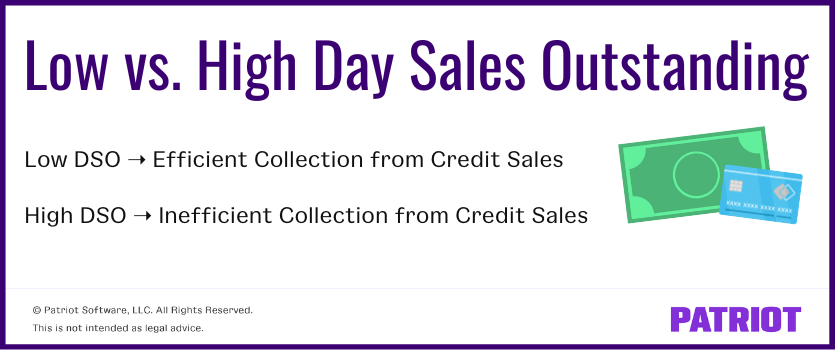Do some of your customers pay on credit? If so, do you know how long it takes your business to collect payments from said credit sales? If not, it’s time to get to know day sales outstanding (DOS). Learn all about day sales outstanding and how to calculate DSO like a pro below.
What is DSO?
Day sales outstanding, or DSO, measures the average number of days it takes a business to collect payments from sales paid on credit (aka account receivables). DSO can tell you how many days it takes your company to convert credit sales into cash.
Days sales outstanding may also be referred to as days receivables or average collection period. You can measure DSO on a monthly, quarterly, or annual basis.
Day sales outstanding formula
To find out how long it takes your business to convert credit sales into cash, you need to know the DSO formula like the back of your hand. Check out the day sales outstanding formula below.
DSO = (Accounts Receivables / Total Credit Sales) X Number of Days
DSO only accounts for credit sales, not cash sales. To calculate DSO, gather your accounts receivables (i.e., money owed to you) and total credit sales (i.e., purchases paid on a credit) for the time period. Once you get that information, you can plug it into the above formula and multiply it by the number of days in the period.
How to calculate day sales outstanding: Example
Want to see DSO in action? Let’s take a look at an example of how it works.
Say your company wants to find its DSO for the month of December. You have $15,000 in accounts receivable and $45,000 in total credit sales. There are 30 days in the month.
DSO = (Accounts Receivables / Total Credit Sales) X Number of Days
DSO = ($15,000 / $45,000) X 30 Days
DSO = 0.33 X 30 Days
Your company’s DSO for the month is 10 days (0.33 X 30 days). This means it takes your company, on average, 10 days to collect on a credit sale.
To find quarterly DSO, multiply by the number of days in a quarter (e.g., 92 days in Quarter 4). And to get your annual DSO, simply multiply by 365 days (unless it’s a leap year). Here’s what that would look like with the DSO formula:
Quarterly DSO = (Accounts Receivables / Total Credit Sales) X 92 Days*
Annual DSO = (Accounts Receivables / Total Credit Sales) X 365 Days*
*Number of days in a quarter can vary depending on which quarter you’re looking at. Number of days for annual DSO calculation can vary depending on if it’s a leap year.
What is a good DSO?
So, what does a good DSO look like? What about a bad one?
A high DSO can mean your company is inefficiently collecting cash from credit sales, which can impact your cash flow. On the other hand, a low DSO means you have an efficient cash collection from credit sales process.

In short, a high DSO shows a business isn’t collecting money from credit sales quickly or efficiently enough. A low DSO shows that a business takes fewer days to collect accounts receivable.
There is no universal DSO number to shoot for. You should aim to keep your DSO number low, but not too low. A number that is too low can show your company is too strict with payments.
Keep in mind that DSOs can vary by company and industry. For example, a DSO of 60 days could be the industry standard in one industry, while 60 days could be a concerning number for a company in another industry.
Do your research to determine your industry standard to see where your business’s DSO stands.
Improving your day sales outstanding
Unhappy with your DSO? Don’t worry—there’s always room for improvement. If you have an unhealthy DSO, you can improve it by:
- Collecting payment upfront
- Giving customers multiple ways to pay (e.g., cash, checks, credit cards, etc.)
- Limiting credit approval
- Updating payment terms
- Improving invoicing processes with accounting software
- Offering incentives for quicker payments from customers
- Automating customer payments (e.g., pay online, set up recurring payments, etc.)
- Following up on unpaid invoices
Even if your DSO is healthy, it’s still a good idea to have processes in place to ensure you get paid quickly. That way, you can keep your DSO healthy and improve your business’s cash flow.
Need an easy and affordable way to receive payments quickly from customers? Patriot’s online accounting software makes accepting credit card payments from customers a breeze. Try it free for 30 days today!
This is not intended as legal advice; for more information, please click here.


